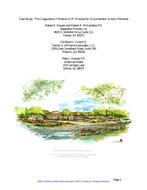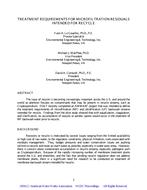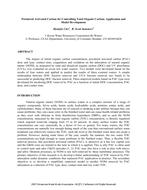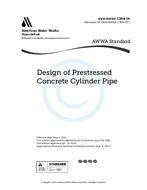Provide PDF Format
AWWA WQTC64028
- Case Study: The Coagulation Filtration (C/F) Process for Groundwater Arsenic Removal
- Conference Proceeding by American Water Works Association, 11/01/2006
- Publisher: AWWA
$12.00$24.00
As a result of the 2006 arsenic MCL change, Arizona American Water (AAW) was required toconstruct several arsenic removal facilities within the Phoenix, Arizona metropolitan area.Coagulation/filtration (C/F) was the treatment technology selected for AAW's two largestcentralized facilities. The new C/F facilities, which were designed by Damon S. WilliamsAssociates (DSWA), treat a combined maximum average flow of approximately 24 MGD; basedon available equipment and plant hydraulics, the maximum treatment capabilities are as large as28 MGD.Since the C/F process is capable of achieving high arsenic removal, a portion of the raw waterflow from the wells is allowed to bypass the treatment system and blend with the lower arsenicwater exiting the C/F process. The facilities have been designed to meet a finished water arsenicgoal of 8 µg/L, which provides a factor of safety to ensure compliance with the 10 µg/L MCL.The portion of the flow that is fed to the treatment system is dosed with ferric chloride underhigh rate mixing. During coagulation, arsenic binds to the iron and is co-precipitated with ferrichydroxide. Following coagulation, the water passes through horizontal dual media pressurefilters, wherein the arsenic-bearing ferric hydroxide particles are removed from the flow. Thefilter effluent combines with the treatment system bypass water prior to storage and subsequentdistribution to the local potable water supply system. The filters are backwashed periodically toremove accumulated iron solids. Following backwashing, the solids are settled and thickenedprior to disposal.In addition to the overall scale of the arsenic removal systems, which are some of the largest C/Farsenic removal facilities in the southwest, the facilities are unique because of process equipmentselection and design requirements imposed by local conditions. Because multiple rounds ofbench-scale and pilot tests were conducted to validate the process design, the facilities can beused to compare literature and pilot scale testing results to full-scale arsenic removal resultsobtained during facility operation. Includes 7 references, table, figures.
Related Products
AWWA WQTC55206
Treatment Requirements for Microfiltration Residuals Intended for Recycle..
$12.00 $24.00
AWWA WQTC65764
Powdered Activated Carbon for Controlling Total Organic Carbon: Application and Model Development..
$12.00 $24.00





